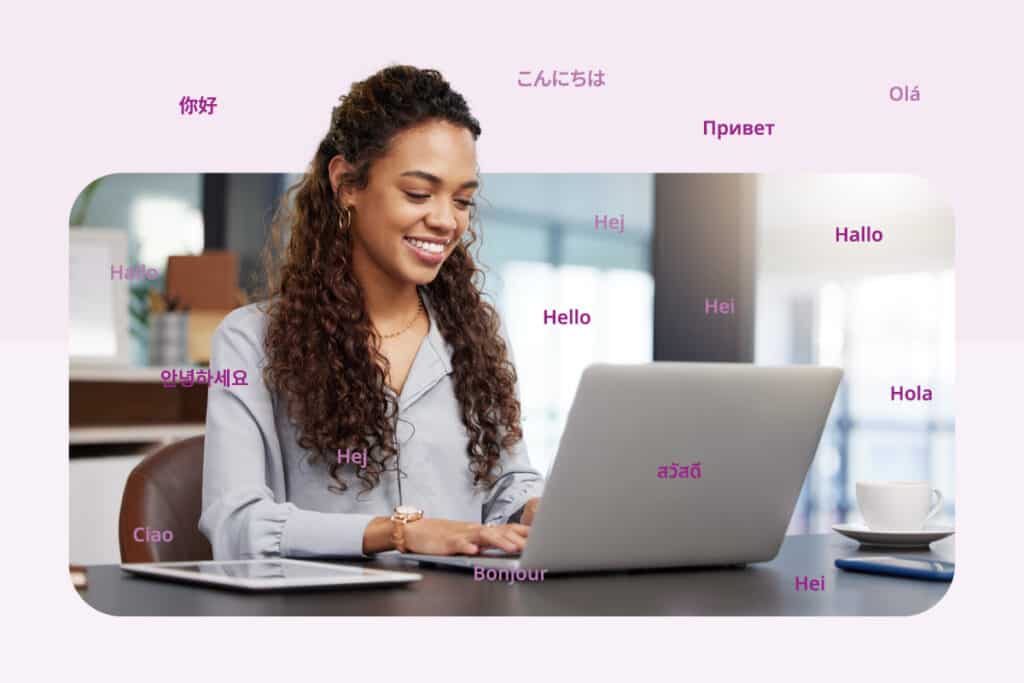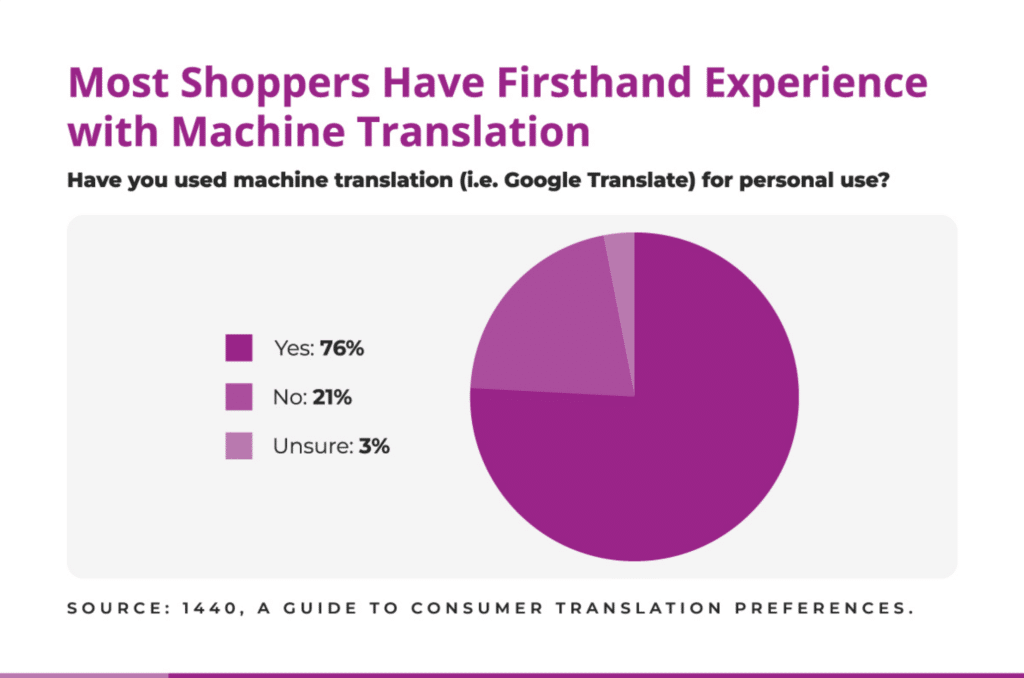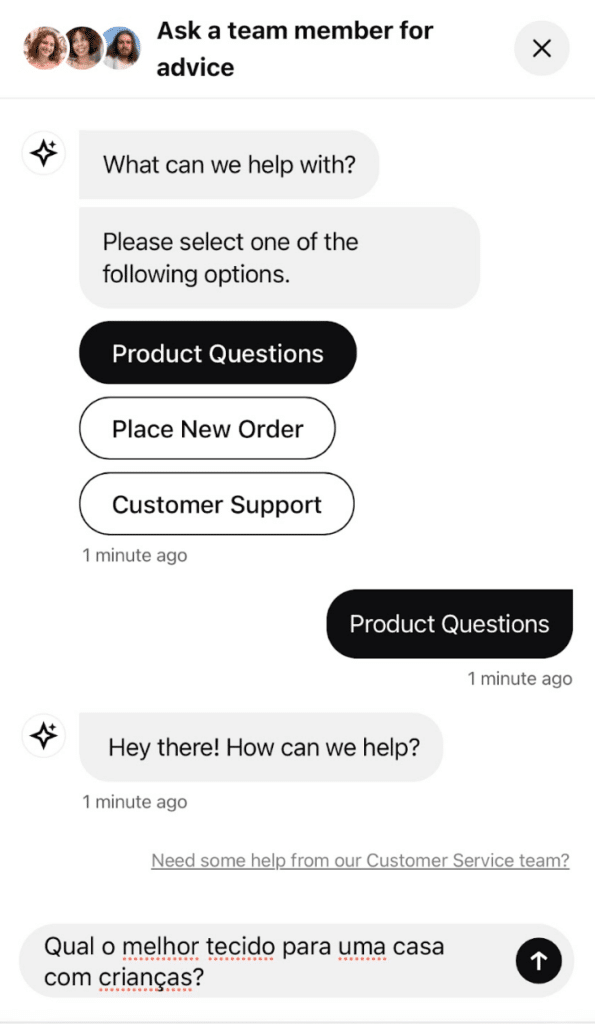4 Ways Machine Translation Can Empower Your Customer Care Team

Once upon a time, not so long ago, the world felt like a huge place. But thanks to the rise of the internet and the rapid evolution of technology, it’s starting to feel a whole lot smaller.
Today, it’s relatively easy for a consumer to buy something from a brand halfway across the world. And often, employees must collaborate with team members from every corner of the globe.
Sure, language barriers are bound to crop up. But winning brands are tapping into machine translation to improve internal collaboration and fuel winning customer experiences in any language.
Read on to explore four of the top ways machine translation can empower your customer care teams – and make it a whole lot easier for them to do their jobs.
What is Machine Translation?
Machine translation is the use of artificial intelligence (AI) to translate text from one language to another – without the involvement of a human.
Machine translation isn’t a new concept. During the Cold War, a company called SYSTRAN developed translation software to translate intelligence materials from Russian to English.
Early machine translation was certainly innovative for the time. But it relied on rule-based methods, which led to problems with nuance, word reflection, and word order. In other words, things were often “lost in translation.”
The speed and quality of machine translation continue to improve every day. More and more, translations sound like they’ve come from actual humans – rather than machines.
Today, there are several major translation engines available – including Google Translate, DeepL, AWS, and Microsoft Translator – that consumers use in their personal and professional lives. In fact, a recent survey found more than three-quarters of consumers have used machine translation for personal use.

While machine translation is constantly improving, there are instances when a human translator needs to be brought in. In those situations, a partner like TransPerfect is ideal.
How Machine Translation Benefits Your Customer Care Team
Now that we’re in alignment about what machine translation is, let’s dig into four of the key ways it benefits customer care teams.
Benefit #1: Machine Translation Saves Time
Customer expectations have never been higher. As a result, customer care case volumes are growing, and cases are becoming increasingly complex.
Yet, customer care resources often remain flat. In fact, some companies have even reduced their customer care headcounts.
So is it really any wonder that nearly 8 in 10 service agents find it difficult to balance speed and quality?
78% of service agents say it’s difficult to balance speed and quality.
Salesforce State of Service 5th Edition
Translating communications with customers takes time. Agents may have to send translations out to a third-party service. Or, they can copy and paste communications into a translation engine like Google Translate. But even that takes time. And they don’t have any time to spare.
Machine translation can automate the entire process – and free up your customer care agents’ time to handle more complex tasks.
Imagine a US-based customer care team that uses Salesforce Service Cloud. One of the agents receives a live chat from a customer in Portugal, written in Portuguese. If they use a solution like Translation Studio from 1440, that message will automatically be translated to English for the agent to read. The agent can then type their response in English – and it’ll be translated into Portuguese. All of this happens right within Salesforce.

The agent can break down language barriers – without sinking extra time into doing so.
Benefit #2: Machine Translation Empowers Customer Care Teams to Deliver Winning Customer Experiences
When it comes to customer experience, a one-size-fits-all approach won’t cut it. Today, consumers demand outstanding, personalized experiences throughout the entire purchase journey.
A company’s ability to deliver great experiences determines whether or not a consumer will make a purchase. According to Salesforce, 71% of consumers have made purchase decisions based on the quality of customer service.
A big part of delivering great experiences is the ability to communicate in your customers’ preferred languages.
A recent survey found that 82% of consumers expect a brand in a different country with a different native language to be able to communicate with them in their own native language. 89% have this expectation when interacting with a brand in the same country with a different native language.
Native Language Communication is Expected
1440, A Guide to Consumer Translation Preferences
- 82% expect a brand in a different country with a different native language to be able to communicate with them in their own native language.
- 89% expect a brand in the same country with a different native language to be able to communicate with them in their own native language.
What’s more, consumers expect brands to be able to communicate with them in their preferred channel via myriad channels – from email and live chat to social media messaging and WhatsApp.
Customer care teams simply can’t meet shoppers’ expectations for native language communication if they don’t have the tools to do so.
Language barriers are bound to arise. And customers expect you to break them down. Machine translation empowers your customer care teams to communicate with any customer in any language. And when you use a solution like Translation Studio from 1440, these translations are all automated right within Salesforce.
Benefit #3: Machine Translation Improves Internal Collaboration
In the past, customer care agents primarily collaborated with coworkers within the same office. Today, geographically dispersed workforces have become the norm.
When customer care agents are collaborating with team members across the globe, language barriers are bound to pop up.
For example, consider a US-based customer care agent who has an interaction with a customer in the US via WhatsApp. The conversation is in English – as are the notes the agent has included in the case. A few months down the road, the same customer reaches out again – but they’re connected with an agent in Argentina. The agent isn’t proficient in English, so they’re unable to understand the previous conversation and the notes from the US-based agent. This is frustrating both for the customer care agent and the customer.
Machine translation can break down those internal language barriers to fuel more effective collaboration.
Let’s return to the example we mentioned earlier, with the customer care agent in Argentina. With machine translation, the agent can automatically translate the customer’s previous conversation with the US-based agent and that agent’s notes. The Argentinian agent now has more context and can provide a better experience to the customer.
Benefit #4: Machine Translation Improves Employee Experiences
It’s hard to find great customer care talent. And it’s even harder to retain that talent. According to research from McKinsey & Company, nearly half of customer care organizations have reported employee attrition increases in the past 12 months.
Customer care team members leave their jobs for myriad reasons. But a poor experience ranks high on the list.
Improving employee experiences must be a top priority. A big part of this is equipping your customer care teams with the tools they need to do their jobs well. This includes machine learning tools.
If a customer care agent doesn’t have the tools to engage with a customer in their preferred language, it’ll lead to frustration. If this happens a lot, they may jump ship.
Remember: happy, engaged employees are better equipped to provide winning experiences that lead to satisfied customers. Equipping them with the right tools – including translation tools – is essential.
Start Empowering Your Customer Care Teams with Machine Translation Tools
The world is getting smaller each day. Customer care agents are bound to face language barriers – both when interacting with customers and collaborating with coworkers.
Brands must provide their customer care teams with the tools necessary to break down these language barriers. This is essential to driving better employee and customer experiences.
Now’s the time to get started. Ready to see how Translation Studio from 1440 can empower your customer care teams to communicate with any customer or colleague in any language – without leaving the security of Salesforce? Contact us to schedule your free demo today.